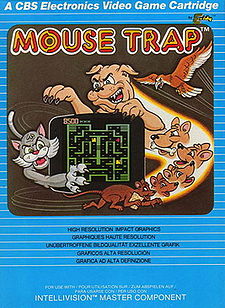- Mouse Trap (arcade game)
-
Mouse Trap 
Developer(s) Exidy Publisher(s) Exidy Designer(s) Larry W. Hutcherson Platform(s) Arcade, Atari 2600, ColecoVision, Intellivision Release date(s) 1981 Genre(s) Maze Mode(s) Up to 2 players, alternating turns Cabinet Upright CPU M6502 (@ 705.562 kHz) Sound M6502 (@ 894.886 kHz), Z80 (@ 1.789772 MHz)
Custom (@ 1.789772 MHz), HC55516 (@ 1.789772 MHz)Display Raster resolution 248×256 (Horizontal) Palette Colors 8 Mouse Trap is a 1981 arcade game released by Exidy, similar to Pac-Man. It was ported to three home systems by Coleco; Coleco's ColecoVision, Mattel's Intellivision, and the Atari 2600.
Contents
Comparison to Pac-Man
Many differences between Pac-Man and Mouse Trap are aesthetic: the dots become cheese, the player is a mouse, the ghosts are cats, and power pills are bones that turn the player into a dog.
There are other functional differences as well:
- The player can open and close the yellow, red, and blue sets of doors at the press of a matching colored button.
- The player can store dog bones for later use at his or her discretion by pressing a fourth button — a large round "Doggie Button" with a picture of the dog's head on it.
- The four ghosts are replaced by six cats, worth 100 points for the first cat eaten, 300 for the second, 500 for the third, 700 for the fourth, and 900 for the fifth and subsequent cats. Point values reset when another bone is used. Each cat eaten spawns a slightly faster replacement.
- A seventh monster, a hawk, will eat both mouse and dog. Only the mid-screen "IN" field stops the hawk, by causing it to move randomly instead of chasing the player, but this will beam the mouse into one of the four corners.
- Bonus point prizes do not appear at intervals, but are constantly available. Eating one triggers the next in the series to appear. Point values start at 1000 for the first prize and increase by 200 for each subsequent prize, with the last prize being worth 7200 points. When the last prize is eaten, the sequence restarts. There are thirty-two in all: a wedge of Swiss cheese, a paperclip, a safety pin, a key, an apple, a trophy, a candlestick, a pair of scissors, a pair of pliers, a pair of eyeglasses, a clock, a bottle, a gem, a bugle, a screw, a hammer, a diamond ring, a light bulb, a sewing needle, a fork, a thimble, a knife, a cocktail glass, a fishbone, a pear, a peanut, a die, a telephone handset, a die with "C A F" on the faces, a spool of thread, a teacup, and a pistol.
- There is a 10,000 point bonus for clearing the board of all cheese. A player who ends a stage as a dog will begin the next stage in that form.
 The Atari version - cover art
The Atari version - cover art
Ports
Coleco ported Mouse Trap to its own ColecoVision console, with fewer prizes, an option to leave the hawk out, and different sound effects. Coleco's Intellivision port adds an audio warning when a cat is about to enter the maze, but suffers from blocky graphics.
Coleco also ported Mouse Trap to the Atari 2600, simplifying graphics and gameplay. The maze is more squat with brighter walls, and doors form a single colored set that flickers. Gameplay basics are the same, but the hawk, the "IN" area, and the bonus prizes are missing, there are three cats instead of six, and all doors move at once. Scoring is also reduced significantly: cheese is worth 1 point instead of 10 points, cats are worth 10 points and do not increase in value, and clearing a maze awards only 100 points.[1]
In popular culture
In 1982, Buckner & Garcia recorded the song "Mousetrap" using sound effects from the game, and released it on the album Pac-Man Fever. When they rerecorded the album in 1999, they were unable to find a machine and used sounds from nature, instead.
See also
References
External links
- Mouse Trap at the Killer List of Videogames
- Mouse Trap guide at StrategyWiki
- Mouse Trap at MobyGames
Categories:- 1981 video games
- Arcade games
- Atari 2600 games
- ColecoVision games
- Exidy games
- Intellivision games
- Maze games
- Pac-Man clones
Wikimedia Foundation. 2010.
